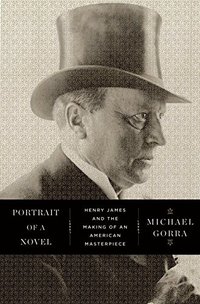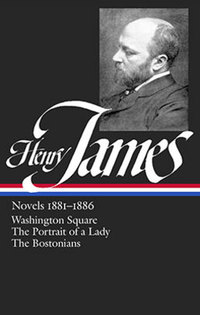
Guest blog post by Michael Gorra, Mary Augusta Jordan Professor of English Language and Literature at Smith College and author of the recently published Portrait of a Novel: Henry James and the Making of an American Masterpiece.
One October day many years ago I sat in a college classroom and wondered why the book on my desk wasn’t the same as the one the professor held in his hand. They were each called The Portrait of a Lady, and yet I couldn’t make the words he read aloud match up with the ones on the page before me. Henry James’s heroine was named Isabel Archer, and I could follow nicely when my teacher read that “she had had everything that a girl could have.” But it seemed that James then went on to specify. “Everything” included “the latest publications, the music of Gounod, the poetry of Browning, the prose of George Eliot.” The girl in my book didn’t have all that, she got only “a glimpse of contemporary aesthetics,” and I cursed myself for having gotten a cheap used copy instead of the new Penguin in the college bookstore. Mine was clearly abridged—and yet why didn’t it say so?
I’d like to report that I promptly put up my hand and asked what was going on, but I was shy and instead just bumbled along for the rest of the class and even on into the next week. The novel ends with a famous kiss, and my book told me that it was “like a flash of lightning.” My teacher’s said something more. On his pages that “kiss was like white lightning, a flash that spread, and spread again, and stayed,” and so on for another fifty words. Well, the book had hit me like that, and even in what I thought was my own defective copy. It was time to get a good one.
The truth is that The Portrait of a Lady exists in two versions. You can read the text James published in 1881, or you can get the one that he revised twenty-five years later for what he called the New York Edition of his works. James had always tinkered with his own published works, marking them up and trying to make them better, even if the changes were for his eyes only. Then in 1905 he started to plan a definitive edition of his novels and tales, an edition “selective as well as collective; I want quietly to disown a few things.” As part of that, the early books that had made his name—stories like “Daisy Miller,” novels like the Portrait itself—would have their surfaces rubbed over, their style nudged or even kicked into line with that of his later work. Or as he himself put it, he would close the gap between “the march of my present attention…[and] the march of my original expression.”
My teacher had ordered the text of the New York Edition, which had become the classroom standard. I was reading the 1881 version, which some publishers had continued to use and which remained a staple of used bookstores and libraries. And over the years I’ve seen my own early puzzlement duplicated on the faces of one student after another; though I’m happy to say that they’re not at all reluctant to ask about those discrepancies. Put simply, the difference lies in the metaphoric weight and physical pungency of the older writer’s language. In 1881 Isabel waits to see her sick cousin Ralph, and grows “impatient at last; she grew nervous and even frightened.” In the later text, which James revised in 1906 and published in 1908, she grows “nervous and scared—as scared as if the objects about her had begun to show for conscious things, watching her trouble with grotesque grimaces.” The style in that later version is without question richer and more complicated.
Whether it’s an improvement is another question. James’s early texts have a lightness of touch that better suits his youthful comedy, and some readers have always preferred the relatively straightforward prose of those first editions. But his language had already begun to grow full by the time he wrote the Portrait, and the book can sustain the black brocade of his later manner.
Still, the changes are extensive. There’s something new in almost every paragraph, and the pages on which James made his revisions—you can see them at Harvard’s Houghton Library—seem an almost illegible confusion of word-balloons, of lines and arrows and scribbled interjections. His revisions are so great, in fact, that some critics believe we really have two Isabels, and maybe even two different novels.
The literary historian Nina Baym, for example, has argued that the 1881 Portrait is concerned with the social questions of its moment, and especially with the position of women in a world where their fate still depends upon marriage. The New York Edition, in contrast, offers us an interior drama, a modernist account of its heroine’s mental processes. One version concentrates on her “independence”; the other on her “awareness.” James’ revisions certainly do focus our attention on Isabel’s inner life, and even on what his brother, the philosopher William James, had called “the stream of consciousness.” Yet the later chapters of the novel’s first edition were already moving in that direction. James’s revisions don’t change it so much as they make its opening movements fit the book that it had by its last pages become.

The Library of America has, however, chosen to use the first version in its volume of James’s Novels, 1881–1886, and for their purposes that seems to me the only defensible choice. James left some major works out of the New York Edition, such as The Bostonians, and saw no need to revise his later novels in the same way as he had the Portrait. Both consistency and chronology demand that the Library make the decision it has in fact made: to print an early book version of each work.
And me? For my classes I have always ordered James’s revised edition, and expect I’ll go on doing so; I can’t do without that kiss in all its fullness. In writing about Isabel’s story, however, I’ve chosen to use the 1881 edition as my primary text. My new book, Portrait of a Novel, is a critical biography that looks at James’s life and work through the lens of his first great novel. It’s a study of development, of James in the act of becoming; a writer who wasn’t yet a monument, not yet the figure whose disciples would call him The Master. Instead of looking back to the novel’s early version as something discarded, I look forward to its later one as a form of culmination. The paradox is that in doing so I’ve become oddly happy that I began, so many years ago, by buying the wrong book.



